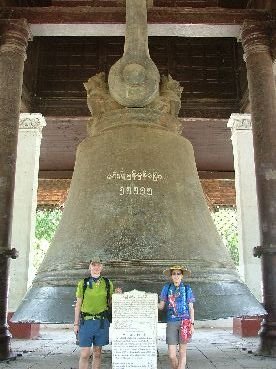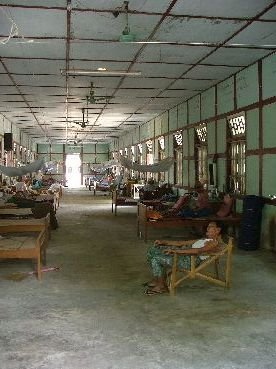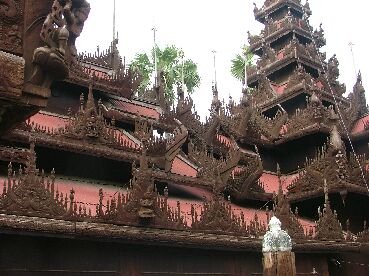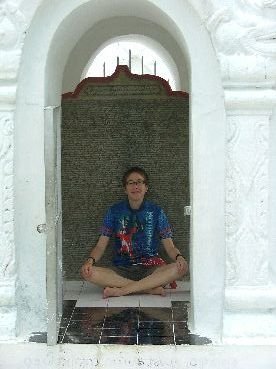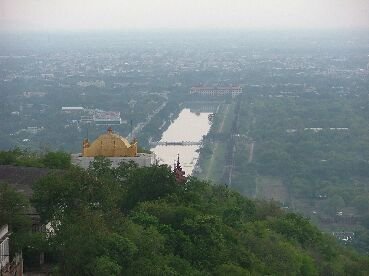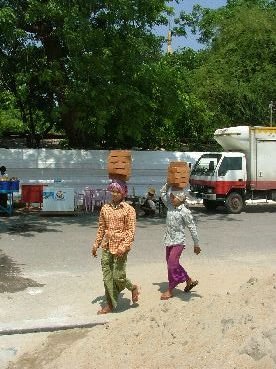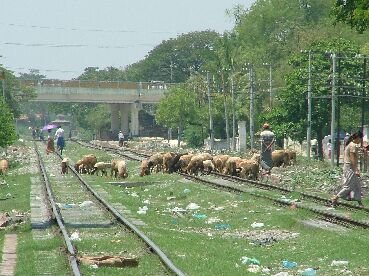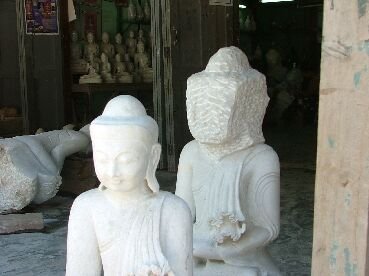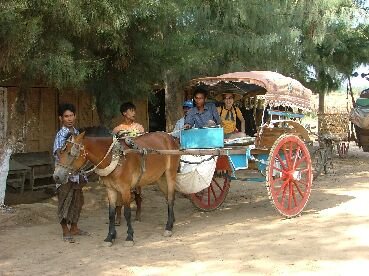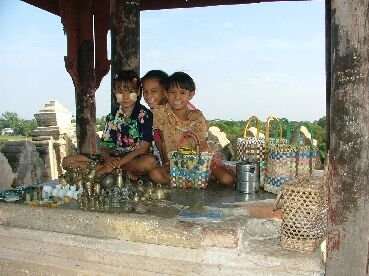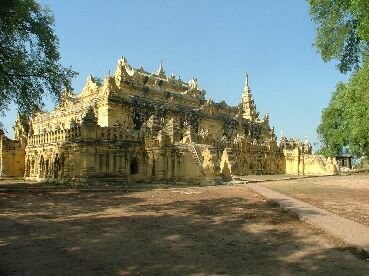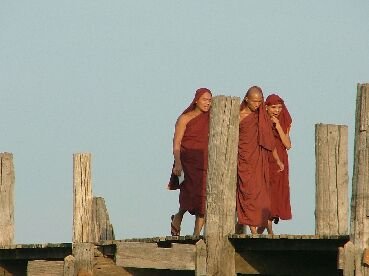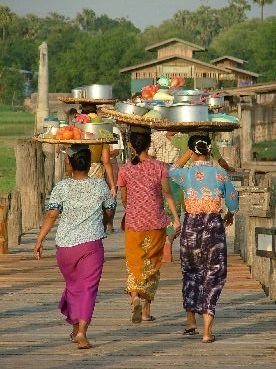|
|
WhereAreJanetandRick Myanmar |
|
Mandalay and Environs
Mingun
Mandalay was once the capital of the country and is now the most modern city. It is large, heavily populated, spreadout and noisy. Arround Mandalay there are five ancient cities which have lovely ancient architecture and culture. Mingun is only accessible from Mandalay by boat and makes for a pleasant day trip. Here you can see the town in the distance as we approach by boat.
The main attraction of Mingun are these ruins of the unfinished Mingun Pagoda. It was intended to be the highest pagoda in the world and the base was built with amazing structure. Unfortunately, the King Bodawpaya died before his dream could come true and this is all that there ever was and still is since 1819.
Can you spot the new stupa??? Yes Janet is finally wearing a new t-shirt and hat!
This bell had been cast for the pagoda. It is 90 tons weight , which is said to be the largest, undamaged bell of the world.
This is the Mingun Sanatoriuma home for the aged. It is quite a remarkable place and exists thanks to donations.
Mandalay
This is the Shwenandaw Monastery; It is made of Teak and actually survived WWII.
The world's biggest book has 730 leaves or 1460 pages each measuring three and a half feet wide, five feet long and five inches thick.
Each leaf is put upright on a stand of its own and all these stands occupy a square compound of thirteen acres. Janet is taking a rest between pages!
Mandalay, was named after the Mandalay Hill, which is situated at the northeast corner of the present city. The hill has for long been a holy mount and it is believed that Lord Buddha prophesied that a great city, metropolis of Buddhism, would be founded at its foot. It was King Mindon who fulfilled the prophecy.
At the time of building, the royal moat was 68.58m wide and 3.35m deep, and was fed with water from the Yadana Nadi, now called the Ye Ni Canal. In 1995 the moat was dug renew and the banks were laid neatly and firmly with rocks. There existed 20 gardens, a huge earthen wall and 57 doors palace. There existed 5 bridges spanning over the moat and 12 bridges. At present, there are four spanning bridges, namely the U-hteik Bridge to the east the Kyaw Moe Bridge to the south, the Kye Mon Bridge to the west and the Lay Thein Bridge to the north. Mandalay today is a striking phenomenon composed of modern and classic images. The royal palace and the moat surrounding it, can be viewed from the beauty of Mandalay Hill. At the time of building, the royal moat was 68.58m wide and 3.35m deep, and was fed with water from the Yadana Nadi, now called the Ye Ni Canal. In 1995 the moat was dug renew and the banks were laid neatly and firmly with rocks. There existed 20 gardens, a huge earthen wall and 57 doors palace. There existed 5 bridges spanning over the moat and 12 bridges. At present, there are four spanning bridges, namely the U-hteik Bridge to the east the Kyaw Moe Bridge to the south, the Kye Mon Bridge to the west and the Lay Thein Bridge to the north.
This is the holiest temple in Mandalay: aka Great Sage Pagoda. It was originally built in 1784 and almost completely rebuilt after a fire in 1884. It holds the Mahamuni image, from as early as the first century AD. The four-meter bronze image of the seated Buddha has been covered by application of gold leaf and over time has more than doubled its original weight. Only the original face can now be seen.
Believers feel that one can benefit from applying gold to that area of this particular Buddha where one wishes to maintain good health. In this pagoda, women are not allowed to touch the Buddha and have to sit in a separate place. Rick applied gold leaf for both of us! (See below)
This is Rick pounding the gold leaf. The process is very long & labour intensive. The gold is pressed into strips and then pounded for 5 hours until it spreads thin. It is then relayered and pounded again and again. This 3 step pounding process yields gold-leaf that is thinner than a hair. They are sold in all pagodas for applications to the Buddhas for good luck.
When leaving the Great Sage Pagoda we walked by a huge pile of bricks. Then, to our amazement, we saw these women moving the bricks to a new construction area by piling them on their heads.
Ever wonder why Myanmar trains are oft delayed?
After seeing so many statues of Buddha it was interesting to see the work at the stone carvers’ workshop.
Inwa
Another of Mandalay’s ancient cities, Inwa, is reached after a short boat trip across the river. Inwa was formerly known as Yadana Pura. It was first founded as a capital by King Thado Minbya in 1364 A.D. Later kings shifted the capital from Inwa back and forth many times until King Bayint Naung's son King Nyaung Yan re-established his capital at Inwa in 1596 A.D. It continued to be capital till 1782 when Bodawpaya moved the capital to Amarapura. But his son King Bagyidaw moved his capital back to Inwa. It was destroyed by the earthquake of 1838. The ruins of the palace, the massive fort walls and moat can still be seen.
The Bagaya Monastery was built on the southwest of Inwa palace on 1593. It has a three-tiered roof and its adjacent religious lecture hall, in the eastern side of the monastery, has a seven-tiered roof. The monastery has 267 teak posts. The largest teak post is 9 feet in circumference and 60 feet high. The monastery is 118 feet long and 103 feet wide. The entire building is decorated with carvings in floral arabesques. It is ornamentated with curved figurines and the reliefs of birds and animals. Small pillars on the wall are decorated with tunnery, the artistic works of Innwa Era. Large teak doors are also beautifully crafted with sculptures and reliefs.
The grand monastery exists today in its original form. It is considered an ancient art museum.
Our 2nd stop in Inwa was the Nan Myint watch tower. This leaning tower is a 90 feet high masonry structure. It is all that remains of a palace built by King Bagyidaw (1819-1837) and destroyed when a great fire broke out during his reign.
These cheerful souvenir sellers greet you when you climb to the top.
This is a brick-and-stucco monastery built by the Chief Queen of King Bagyidaw for her royal abbot (Nyaung Gan Sayadaw) in 1818. Monasteries were normally built of wood and were prone to deterioration from the elements or destruction by fire. Although this monastery was built in imitation of the traditional wooden style, its masonry construction has ensured its survival. The 1838 earthquake badly damaged it, but in 1873 it was restored.
Amarapura
The Mahagandayon temple area was built in the 1950's and is architecturally not particularly interesting. But Mahagandayon is the largest Buddhist monastery in Myanmar accommodating more than 1,000 monks during the Buddhist Lent. About 700 monks reside in the monastery all year round.
While we were there a bell tolled and countless monkswith books under arm started filing into one of the buildings. These guys at left, however, appeared to be on clean-up duty.
The U Bein Bridge is about three quarter of a mile, crossing the Taung-tha-man Inn (lake). It is the longest teak bridge in the world and is about two centuries old.
This bridge became to be known as U Bein Bridge after the name of the donor, U Bein who was a clerk to the Mayor of Amarapura. It was constructed in 1849 from old planks and timber posts of dismantled houses in Sagaing and Inwa. It took nearly two years to finish, but since it was opened in 1851 it has constantly been in use by the people and in recent years by foreign visitors also. There are now 1086 posts and 482 spans. At 9 points, were what served as drawbridges which were built to allow the royal barges and war boats to go under the bridge and out to the Ayeyarwadi River in the old days.
These women operate food stalls on one side of the bridge and live on the other.
| |||||||||||||||||||||||||||||||||||||



